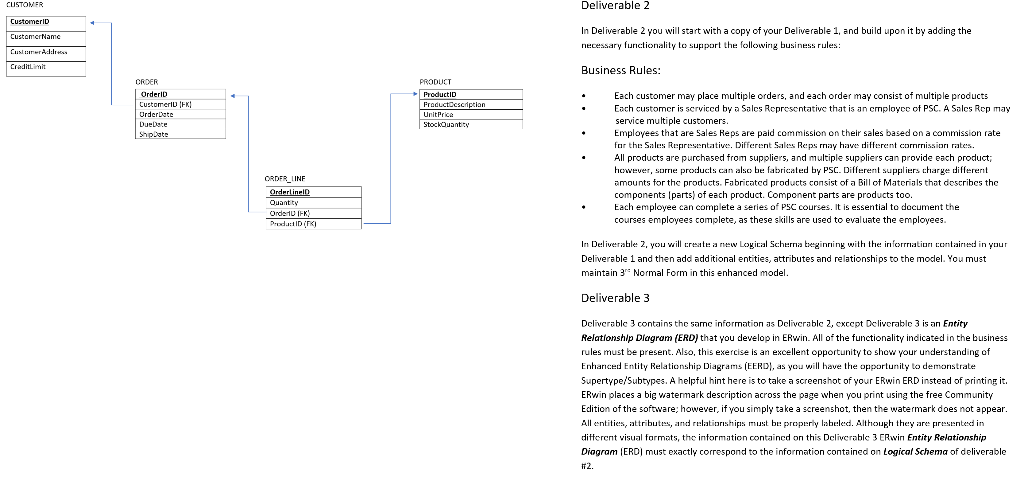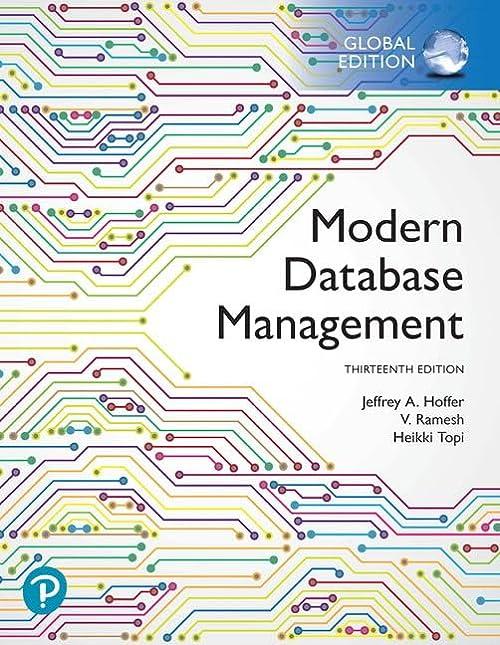
CUSTOMER Deliverable 2 Customerid CustomerNamc In Deliverable 2 you will start with a copy of your Deliverable 1, and build upon it by adding the necessary functionality to support the following business rules: Cusledila Creditimit Business Rules: PRODUCT CRDER Orderib Customeriu 1 Order Date Dueliste Shpoate ProductID Froductcscription Unit Price StockOuantity Each customer may place multiple orders, and each order may consist of multiple products Each customer is serviced by a Sales Representative that is an employer of PSC. A Sales Rep may service multiple customers. Employees that are Sales Reps are paid commission on their sales based on a commission rate for the Sales Representative. Different Sales Reps may have different commission rates. All products are purchased from suppliers, and multiple suppliers can provide each product; however, surne products can also be fabricated by PSC. Different suppliers charge different amounts for the products. Fabricated products consist of a Bill of Materials that describes the components (parts) of each product. Component parts are products too. Each employee can complete a series of PSC courses. It is essential to document the courses employees complete, as these skills are used to evaluate the employees. ORDER_LINE OrderlinID Quantity Orde-10 IFK) Desi FKI In Deliverable: 2, you will create a new Logical Schema beginning with the information contained in your Deliverable 1 and then add additional entities, attributes and relationships to the model. You must maintain 3- Normal form in this enhanced model. Deliverable 3 Deliverablc 3 contains the same information as Deliverablc 2, cxccpt Deliverablc 3 is an Entity Relationship Diagram (ERD) that you develop in Erwin. All of the functionality indicated in the business rules must be present. Also, this exercise is an excellent opportunity to show your understanding of Enhanced Entity Relationship Diagrams (EERD), as you will have the opportunity to demonstrate Supertype/Subtypes. A helpful hint here is to take a screenshot of your ERwin ERD instead of printing it. Erwin places a big watermark description across the page when you print using the free Community Edition of the software, however, if you simply take a screenshot, then the watermark does not appear. All entities, attributes, and relationships must be properly labeled. Although they are presented in different visual formats, the information contained on this Deliverablc 3 CRwin Entity Relationship Diagram (ERDI must exactly correspond to the information contained on logical Schema of deliverable 172. CUSTOMER Deliverable 2 Customerid CustomerNamc In Deliverable 2 you will start with a copy of your Deliverable 1, and build upon it by adding the necessary functionality to support the following business rules: Cusledila Creditimit Business Rules: PRODUCT CRDER Orderib Customeriu 1 Order Date Dueliste Shpoate ProductID Froductcscription Unit Price StockOuantity Each customer may place multiple orders, and each order may consist of multiple products Each customer is serviced by a Sales Representative that is an employer of PSC. A Sales Rep may service multiple customers. Employees that are Sales Reps are paid commission on their sales based on a commission rate for the Sales Representative. Different Sales Reps may have different commission rates. All products are purchased from suppliers, and multiple suppliers can provide each product; however, surne products can also be fabricated by PSC. Different suppliers charge different amounts for the products. Fabricated products consist of a Bill of Materials that describes the components (parts) of each product. Component parts are products too. Each employee can complete a series of PSC courses. It is essential to document the courses employees complete, as these skills are used to evaluate the employees. ORDER_LINE OrderlinID Quantity Orde-10 IFK) Desi FKI In Deliverable: 2, you will create a new Logical Schema beginning with the information contained in your Deliverable 1 and then add additional entities, attributes and relationships to the model. You must maintain 3- Normal form in this enhanced model. Deliverable 3 Deliverablc 3 contains the same information as Deliverablc 2, cxccpt Deliverablc 3 is an Entity Relationship Diagram (ERD) that you develop in Erwin. All of the functionality indicated in the business rules must be present. Also, this exercise is an excellent opportunity to show your understanding of Enhanced Entity Relationship Diagrams (EERD), as you will have the opportunity to demonstrate Supertype/Subtypes. A helpful hint here is to take a screenshot of your ERwin ERD instead of printing it. Erwin places a big watermark description across the page when you print using the free Community Edition of the software, however, if you simply take a screenshot, then the watermark does not appear. All entities, attributes, and relationships must be properly labeled. Although they are presented in different visual formats, the information contained on this Deliverablc 3 CRwin Entity Relationship Diagram (ERDI must exactly correspond to the information contained on logical Schema of deliverable 172







